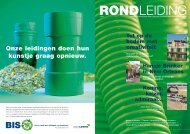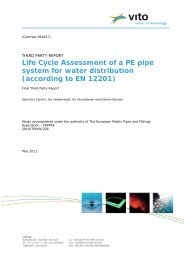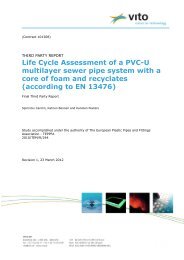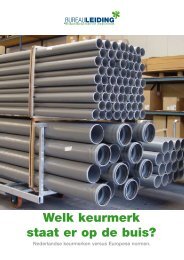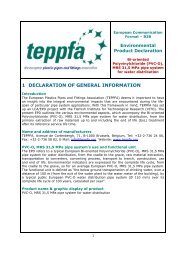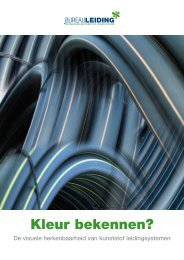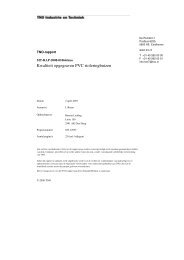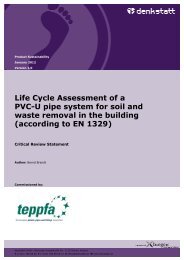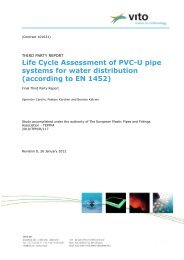Life Cycle Assessment of a PEX pipe system for hot ... - BureauLeiding
Life Cycle Assessment of a PEX pipe system for hot ... - BureauLeiding
Life Cycle Assessment of a PEX pipe system for hot ... - BureauLeiding
Create successful ePaper yourself
Turn your PDF publications into a flip-book with our unique Google optimized e-Paper software.
(Contract 081827)<br />
THIRD PARTY REPORT<br />
<strong>Life</strong> <strong>Cycle</strong> <strong>Assessment</strong> <strong>of</strong><br />
a <strong>PEX</strong> <strong>pipe</strong> <strong>system</strong> <strong>for</strong> <strong>hot</strong> and cold<br />
water in the building (according to<br />
EN ISO 15875)<br />
Final Third Party Report<br />
Spirinckx Carolin, Ive Vanderreydt, An Vercalsteren and Katrien Boonen<br />
Study accomplished under the authority <strong>of</strong> The European Plastic Pipes and Fittings<br />
Association - TEPPFA<br />
2010/TEM/R/230<br />
May 2011
2<br />
All rights, amongst which the copyright, on the materials described in this document rest with the European Plastics<br />
Pipes and Fittings Association (“TEPPFA”), Avenue de Cortenbergh, 71, B-1000 Brussels (Belgium).<br />
The in<strong>for</strong>mation provided in this document is confidential in<strong>for</strong>mation <strong>of</strong> TEPPFA. This document may not be reproduced<br />
or brought into circulation without the prior written consent <strong>of</strong> TEPPFA. Without prior permission in writing from TEPPFA<br />
this document may not be used, in whole or in part, <strong>for</strong> the lodging <strong>of</strong> claims, <strong>for</strong> conducting proceedings, <strong>for</strong> publicity<br />
and/or <strong>for</strong> the benefit or acquisition in a more general sense.
Table <strong>of</strong> Contents<br />
TABLE OF CONTENTS<br />
Table <strong>of</strong> Contents ___________________________________________________________________I<br />
Chapter 1 Introduction _____________________________________________________________ 1<br />
Chapter 2 Goal and scope definition _______________________________________________ 3<br />
2.1 Definition <strong>of</strong> goal <strong>of</strong> the study _____________________________________ 3<br />
2.2 Definition <strong>of</strong> scope <strong>of</strong> the study ____________________________________ 3<br />
Chapter 3 <strong>Life</strong> cycle inventory _____________________________________________________ 7<br />
3.1 Data requirements ______________________________________________ 7<br />
3.2 Data collection procedures ________________________________________ 8<br />
Chapter 4 <strong>Life</strong> cycle impact assessment ___________________________________________ 9<br />
4.1 Method _______________________________________________________ 9<br />
4.2 The environmental pr<strong>of</strong>ile <strong>of</strong> the <strong>PEX</strong> <strong>pipe</strong> <strong>system</strong> <strong>for</strong> <strong>hot</strong> and cold water in the<br />
building ___________________________________________________________ 10<br />
Chapter 5 Final conclusions _______________________________________________________ 13<br />
Chapter 6 Critical review statement ______________________________________________ 15<br />
6.1 Introduction ___________________________________________________ 15<br />
6.2 Review Process ________________________________________________ 15<br />
6.3 Scientific Background ___________________________________________ 16<br />
6.4 Critical Review Findings _________________________________________ 16<br />
6.5 Conclusion ____________________________________________________ 17<br />
List <strong>of</strong> references __________________________________________________________________ 19<br />
I
Chapter 1 Introduction<br />
CHAPTER 1<br />
INTRODUCTION<br />
The European Plastics Pipes and Fittings Association (TEPPFA) deems it important to<br />
have an insight into the integral environmental impacts that are encountered during the<br />
life-span <strong>of</strong> particular <strong>pipe</strong> <strong>system</strong> applications. With this framework in mind, TEPPFA<br />
has set up a project with the Flemish Institute <strong>for</strong> Technological Research (VITO). The<br />
aim <strong>of</strong> this project is to carry out a life cycle assessment (LCA) from cradle to grave <strong>of</strong><br />
4 specific applications <strong>of</strong> <strong>pipe</strong> <strong>system</strong>s. This analysis outlines the various environmental<br />
aspects which accompany the 4 <strong>pipe</strong> <strong>system</strong>s, from the primary extraction <strong>of</strong> raw<br />
materials up to and including the end <strong>of</strong> life (EoL) treatment after their service life time.<br />
With the present document the Flemish Institute <strong>for</strong> Technological Research (VITO) is<br />
reporting on the life cycle assessment (LCA) <strong>of</strong> one specific plastic <strong>pipe</strong> <strong>system</strong><br />
per<strong>for</strong>med on request <strong>of</strong> the European Plastic Pipes and Fittings Association (TEPPFA)<br />
with the final aim to establish an environmental product declaration (EPD). The EPD has<br />
been made according to the CEN framework (CEN TC 350 draft framework documents,<br />
2008 - 2009). This <strong>PEX</strong> LCA is part <strong>of</strong> a larger project where other <strong>pipe</strong> <strong>system</strong>s within<br />
different application areas are analysed by means <strong>of</strong> an LCA.<br />
This document is a summary <strong>of</strong> the LCA study <strong>of</strong> the crosslinked polyethylene (<strong>PEX</strong>)<br />
<strong>pipe</strong> <strong>system</strong> <strong>for</strong> <strong>hot</strong> and cold water at the building and serves as a ‘Third Party Report’<br />
which is aimed at a broad public. TEPPFA can also use the results <strong>of</strong> this LCA study <strong>for</strong><br />
the following purposes:<br />
• to support policy concerning sustainable construction;<br />
• to anticipate future legislation regarding environment and certification (product<br />
development);<br />
• <strong>for</strong> communication with various stakeholders;<br />
• to apply <strong>for</strong> an EPD (Environmental Product Declaration), as described in ISO TR<br />
14025 (ISO, 2006) and the draft prEN 15804 (CEN TC 350 draft framework<br />
documents, 2008 – 2009);<br />
• to focus improvement activities on the most important impact-generating process<br />
phases;<br />
• ...<br />
VITO is the author <strong>of</strong> this comprehensive LCA study which has been carried out under<br />
assignment from TEPPFA. The study was started in early 2009 and was completed in<br />
April 2010. The LCA study has been critically reviewed by Denkstatt (see Chapter 6).<br />
The methodology used to determine the environmental aspects <strong>of</strong> the <strong>PEX</strong> <strong>pipe</strong> <strong>system</strong><br />
<strong>for</strong> <strong>hot</strong> and cold water in the building con<strong>for</strong>ms to LCA methodology, as prescribed in<br />
ISO standards 14040 and 14044 (ISO, 2006). According to these ISO standards, an<br />
LCA is carried out in 4 phases:<br />
1. Goal and scope definition <strong>of</strong> the study;<br />
2. <strong>Life</strong> cycle data inventory (LCI);<br />
3. Determining the environmental impacts by means <strong>of</strong> a life cycle impact<br />
assessment (LCIA);<br />
4. Interpretation.<br />
1
Chapter 1 Introduction<br />
For this project the different environmental impact categories presented in the draft<br />
documents prepared within the technical committee CEN TC 350 “Sustainability <strong>of</strong><br />
construction works” are used (CEN TC 350 draft framework documents, 2008 – 2009).<br />
An overview <strong>of</strong> these categories can be found in the clean version <strong>of</strong> the prEN15804<br />
(Sustainability <strong>of</strong> construction works – Environmental Product Declarations – Core rules<br />
<strong>for</strong> the product category <strong>of</strong> construction products).<br />
The design <strong>of</strong> this third-party report complies with these 4 phases <strong>of</strong> the LCA, whereby<br />
the various chapters describe each phase <strong>of</strong> the LCA. All relevant ISO guidelines were<br />
implemented when compiling this ‘Third Party Report’ (ISO 14044, paragraph 5.2).<br />
2
Chapter 2 Goal and scope definition<br />
CHAPTER 2<br />
GOAL AND SCOPE DEFINITION<br />
2.1 Definition <strong>of</strong> goal <strong>of</strong> the study<br />
TEPPFA wants a cradle to grave LCA consistent with ISO 14040 and ISO 14044 series <strong>of</strong><br />
standards to assess the environmental per<strong>for</strong>mance <strong>of</strong> TEPPFA plastic piping <strong>system</strong>s.<br />
This LCA-study aims to examine the <strong>PEX</strong> <strong>pipe</strong> <strong>system</strong> <strong>for</strong> <strong>hot</strong> and cold water in the<br />
building, to gather and assess comprehensive and reliable in<strong>for</strong>mation regarding the<br />
environmental per<strong>for</strong>mance <strong>of</strong> this <strong>PEX</strong> <strong>pipe</strong> <strong>system</strong>, generated over its entire life cycle.<br />
In the same time, this study helps to provide a reliable database <strong>for</strong> the development<br />
<strong>of</strong> an ISO 14025 Type III Environmental Product Declarations (EPDs) on the European<br />
level <strong>for</strong> the <strong>PEX</strong> <strong>pipe</strong> <strong>system</strong> <strong>for</strong> <strong>hot</strong> and cold water in the building. The CEN framework<br />
(TC 350 – Sustainability <strong>of</strong> construction works) and more specifically the work<br />
per<strong>for</strong>med within the technical committee TC 350 (CEN TC 350 framework documents,<br />
2008-2009) is used <strong>for</strong> this project.<br />
The intended audience <strong>of</strong> the LCA-study <strong>of</strong> the <strong>PEX</strong> <strong>pipe</strong> <strong>system</strong> is the TEPPFA member<br />
companies and its National Associations in the first place and external stakeholders<br />
(like governments, pr<strong>of</strong>essionals, installers) at the second stage. For the latter, TEPPFA<br />
expects to use the in<strong>for</strong>mation from this study in aggregated manner <strong>for</strong> public<br />
communications, to develop marketing materials <strong>for</strong> customers and to provide data to<br />
customers <strong>for</strong> the purpose <strong>of</strong> developing LCIs and EPDs within the building and<br />
construction sector.<br />
Since TEPPFA wishes to publicly communicate the results <strong>of</strong> the LCAs a critical review<br />
and 3 rd party report are per<strong>for</strong>med. This critical review is per<strong>for</strong>med by Denkstatt.<br />
2.2 Definition <strong>of</strong> scope <strong>of</strong> the study<br />
The scope <strong>of</strong> the study is defined in the functional unit. The functional unit is closely<br />
related to the function(s) fulfilled by the to-be-investigated product. The function <strong>of</strong> the<br />
<strong>PEX</strong> Hot & Cold water <strong>pipe</strong> <strong>system</strong> is to supply a typical residential single family<br />
apartment with <strong>hot</strong> and cold drinking water. In consultation with TEPPFA, its steering<br />
committee and the Application Group Building (<strong>for</strong> the <strong>PEX</strong> case) the definition <strong>of</strong> the<br />
function and the functional unit <strong>of</strong> the <strong>PEX</strong> <strong>pipe</strong> <strong>system</strong> was discussed. The basic<br />
assumption was that the definition <strong>of</strong> the functional unit should represent the function<br />
<strong>of</strong> the <strong>PEX</strong> <strong>pipe</strong> <strong>system</strong> over its entire life cycle: raw material extraction, material<br />
production, production <strong>of</strong> the <strong>pipe</strong>s and fittings, the construction phase, the use phase<br />
and the processing <strong>of</strong> the waste at the end <strong>of</strong> life <strong>of</strong> the <strong>PEX</strong> <strong>pipe</strong> <strong>system</strong>. The<br />
functional unit <strong>of</strong> the <strong>PEX</strong> <strong>pipe</strong> <strong>system</strong> <strong>for</strong> <strong>hot</strong> and cold water has been defined as: the<br />
pressure supply and transport <strong>of</strong> <strong>hot</strong> and cold drinking water, from the entrance <strong>of</strong> a<br />
well-defined apartment to the tap, by means <strong>of</strong> a <strong>PEX</strong> Hot & Cold drinking water <strong>pipe</strong><br />
<strong>system</strong> installation supplying a 100 m² apartment, incorporating a bathroom, separate<br />
WC, kitchen and washroom (considering the service life time <strong>of</strong> the <strong>pipe</strong> <strong>system</strong> to be<br />
aligned with the 50 year service life time <strong>of</strong> the apartment), calculated per year”.<br />
3
Chapter 2 Goal and scope definition<br />
In order to define the design <strong>of</strong> the <strong>PEX</strong> <strong>pipe</strong> <strong>system</strong> in terms <strong>of</strong> the functional unit the<br />
following considerations have been made:<br />
• Complete <strong>pipe</strong> <strong>system</strong> is considered;<br />
• Solid wall <strong>PEX</strong> <strong>pipe</strong>, single layer, supplied in coil <strong>for</strong>mat;<br />
• Connections to the several sanitary appliances (siphons, ...) are not considered;<br />
risers, some joints (compression) are included in the design;<br />
• Plastic bodied press fittings in PPSU type material and metal (brass) tie-ins are<br />
considered in the design;<br />
• Brackets and clips are used in only limited numbers (because the <strong>pipe</strong> <strong>system</strong> is<br />
installed into the wall, floor). Although these are only used in limited number, the<br />
impact <strong>of</strong> the production process has been taken into account in this study (at the<br />
installation phase);<br />
• System components usage by weight is taken as the average <strong>of</strong> the weights <strong>of</strong><br />
typical <strong>system</strong> designs <strong>of</strong> two major European suppliers. Since <strong>system</strong>s are<br />
normalised, no major weight differences occur;<br />
• Reference service life time <strong>of</strong> <strong>PEX</strong> Hot & Cold water <strong>pipe</strong> <strong>system</strong> is considered to be<br />
50 year (= service life time <strong>of</strong> building <strong>system</strong>: apartment);<br />
• Building <strong>system</strong>: 100 m² <strong>of</strong> a typical residential single family apartment in a 5-<br />
storeyed building with all the facilities clearly positioned, like bath, shower, etc. The<br />
building design will be used <strong>for</strong> modelling the <strong>PEX</strong> Hot and Cold <strong>pipe</strong> <strong>system</strong> as well<br />
as the PP soil and waste <strong>pipe</strong> <strong>system</strong>. As such the work is harmonized within the<br />
larger LCA-project and a consistent approach is generated over the two building<br />
application cases. For more specific design parameters, we refer to Figure 1.<br />
Figure 1: Design <strong>of</strong> 100 m² <strong>of</strong> apartment (representative <strong>for</strong> the <strong>PEX</strong> Hot and Cold<br />
water <strong>pipe</strong> <strong>system</strong>)<br />
4
Chapter 2 Goal and scope definition<br />
The life cycle <strong>of</strong> the <strong>PEX</strong> <strong>pipe</strong> <strong>system</strong> has been divided in the following different life<br />
cycle phases:<br />
• Production <strong>of</strong> raw materials <strong>for</strong> <strong>PEX</strong> <strong>pipe</strong>s;<br />
• Transport <strong>of</strong> <strong>PEX</strong> <strong>pipe</strong> raw materials to converter;<br />
• Converting process <strong>for</strong> <strong>PEX</strong> <strong>pipe</strong>s (extrusion);<br />
• Production <strong>of</strong> PPSU fittings (raw materials and converting process);<br />
• Production <strong>of</strong> brass fittings (raw materials and converting process);<br />
• Transport <strong>of</strong> complete <strong>PEX</strong> <strong>pipe</strong> <strong>system</strong> to the apartment;<br />
• Installation <strong>of</strong> complete <strong>PEX</strong> <strong>pipe</strong> <strong>system</strong> in the apartment;<br />
• Use and maintenance <strong>of</strong> the complete <strong>PEX</strong> <strong>pipe</strong> <strong>system</strong> during 50 years <strong>of</strong><br />
reference service life time <strong>of</strong> apartment;<br />
• Disassembly <strong>of</strong> complete <strong>PEX</strong> <strong>pipe</strong> <strong>system</strong> after 50 years reference service life time<br />
<strong>of</strong> the apartment;<br />
• Transport <strong>of</strong> complete <strong>PEX</strong> <strong>pipe</strong> <strong>system</strong> after 50 years reference service life time <strong>of</strong><br />
the apartment to an end-<strong>of</strong>-life treatment;<br />
• End-<strong>of</strong>-life waste treatment <strong>of</strong> complete <strong>PEX</strong> <strong>pipe</strong> <strong>system</strong> after 50 years reference<br />
service life time <strong>of</strong> the apartment.<br />
The following underlying principles are adopted when <strong>system</strong> boundaries are<br />
established:<br />
• The infrastructure (production <strong>of</strong> capital goods like buildings, equipment) is not<br />
considered in this study <strong>for</strong> what concerns the converting plants <strong>of</strong> the <strong>PEX</strong> <strong>pipe</strong>s.<br />
For all other processes (production <strong>of</strong> basic materials, additives, energy, transport,<br />
etc.) the impact <strong>of</strong> capital goods is included in the analysis. For example the impact<br />
<strong>of</strong> the <strong>pipe</strong>lines <strong>for</strong> natural gas are considered, as well as the impact <strong>of</strong> the<br />
production <strong>of</strong> transport modes (e.g. trucks) and transport infrastructure (e.g.<br />
roads).<br />
• Accidental pollution is not considered in this LCA;<br />
• Environmental impacts which are caused by the personnel <strong>of</strong> production units are<br />
disregarded. This, <strong>for</strong> example, concerns waste originating from canteens and<br />
sanitary installations. Environmental measures relating to waste processing<br />
processes (combustion kilns, <strong>for</strong> example) are taken into consideration in the LCA<br />
study. Greater focus is placed on the final processing, and thus the end destination<br />
<strong>of</strong> generated waste flows.<br />
• To model different waste treatment processes during the LCA-project we used the<br />
end <strong>of</strong> life (EoL) approach <strong>for</strong> incineration and landfill; and the recycled content<br />
approach <strong>for</strong> recycling:<br />
• For incineration and landfill this means that the impacts (as well as the<br />
benefits: <strong>for</strong> example the energy recovery during waste incineration) <strong>of</strong> the<br />
amount <strong>of</strong> waste that is treated by waste treatment facilities, is assigned to<br />
the producing process (this means the process that causes the waste, so the<br />
<strong>PEX</strong> Hot & Cold <strong>pipe</strong> <strong>system</strong> LCA). Waste that is incinerated with energy<br />
recovery is considered as part <strong>of</strong> the <strong>system</strong> under study. This means that<br />
emissions and energy consumption related to waste treatment are included in<br />
the LCA. For waste incineration the avoided electricity production due to<br />
energy recovery <strong>of</strong> waste incineration is taken into account.<br />
• For waste recycling the credits <strong>of</strong> recyclates (secondary raw materials that can<br />
be used as input materials, so less virgin raw materials needed) are<br />
considered as soon as they are actually used (assigned to the product life<br />
cycle that uses the recyclates). This means that transport to the recycling<br />
plant is included. The recycling process itself and that fact that fewer raw<br />
materials are needed when the produced recyclates (product <strong>of</strong> the recycling<br />
process) are used as secondary raw materials are allocated to the life cycle<br />
where the recyclates are used.<br />
5
Chapter 2 Goal and scope definition<br />
Only <strong>for</strong> some processes there was a need to use so-called ‘cut-<strong>of</strong>f’ rule where the input<br />
on mass basis is lower than 1%:<br />
• Transportation <strong>of</strong> the different packaging waste flows to the respective treatment<br />
facilities;<br />
• The production <strong>of</strong> the packaging materials to pack the raw materials <strong>for</strong> <strong>PEX</strong> <strong>pipe</strong>s,<br />
the PPSU fittings and the brass fittings in order to be able to easily transport them<br />
from the producers to the converters.<br />
For the TEPPFA project VITO uses the different environmental impact categories<br />
presented in the draft documents prepared by Technical Committee CEN/TC 350<br />
(Sustainability <strong>of</strong> construction works – Environmental Product Declarations – Core rules<br />
<strong>for</strong> the product category <strong>of</strong> construction products – presented in the draft prEN15804<br />
(CEN TC 350 framework documents, 2008-2009).<br />
The results <strong>of</strong> an LCA depend on different factors. Sensitivity analyses assess the<br />
influence <strong>of</strong> the most relevant and most uncertain factors on the results <strong>of</strong> the study.<br />
The results <strong>of</strong> these sensitivity analyses are compared to the basic scenarios.<br />
Sensitivity analyses don’t make the basic data <strong>of</strong> a study more reliable, but allow to<br />
assess the effect <strong>of</strong> a change in inventory data on the results and conclusions <strong>of</strong> the<br />
study.<br />
For this project we decided not to put a lot <strong>of</strong> ef<strong>for</strong>t in sensitivity analyses, since it<br />
appears from the life cycle impact assessment <strong>of</strong> the <strong>PEX</strong> <strong>pipe</strong> <strong>system</strong> <strong>for</strong> <strong>hot</strong> and cold<br />
water in the building that the data and the uncertainty on the data <strong>for</strong> the most<br />
important life cycle phases (raw materials <strong>for</strong> <strong>PEX</strong> <strong>pipe</strong>s and transportation <strong>of</strong> these raw<br />
materials to converters) are thoroughly discussed during the workshops. These data<br />
are based on European averages established through PlasticsEurope (<strong>PEX</strong> raw materials<br />
- mainly caused by the PE resin production) or based on company-specific knowledge<br />
on the way the raw materials are transported to the TEPPFA member companies<br />
(averages <strong>of</strong> different individual datasets from different TEPPFA member companies).<br />
To put a lot <strong>of</strong> ef<strong>for</strong>ts into sensitivity analyses on other life cycle phases having a less<br />
important contribution to the overall environmental pr<strong>of</strong>ile was not efficient to our<br />
opinion. For this project additional sensitivity analyses will not have much added value.<br />
6
Chapter 3 <strong>Life</strong> cycle inventory<br />
CHAPTER 3<br />
LIFE CYCLE INVENTORY<br />
3.1 Data requirements<br />
The objective is to compose a dataset that is representative and relevant <strong>for</strong> a typical<br />
European <strong>PEX</strong> <strong>pipe</strong> <strong>system</strong> <strong>for</strong> <strong>hot</strong> and cold water in the building. The data that are<br />
used in this LCA study are not case-specific, but reflect the average European<br />
representative situation. The production processes run according to European<br />
standardised norms and equipment and thus they are very similar across Europe. Since<br />
the LCA study on the <strong>PEX</strong> <strong>pipe</strong> <strong>system</strong> is per<strong>for</strong>med <strong>for</strong> an anticipated European<br />
average, European manufacturer data are used. The TEPPFA member companies<br />
represent more than 50% <strong>of</strong> the European market <strong>for</strong> extruded plastic <strong>pipe</strong>s.<br />
All data relates to the existing situation in Europe, using existing production techniques.<br />
Data are as much as possible representative <strong>for</strong> the modern state-<strong>of</strong>-technology. As<br />
such Europe in the period 2000-2008 is considered as the geographical and time<br />
coverage <strong>for</strong> these data.<br />
The used data are consistently reported and critically reviewed, so that they can be<br />
easily reproduced. If in this document is referred to “a <strong>pipe</strong> <strong>system</strong>”, this means the<br />
<strong>pipe</strong> <strong>system</strong> representing the average at the European level, and not one specific <strong>pipe</strong><br />
<strong>system</strong>. Calculations <strong>of</strong> the amounts <strong>of</strong> <strong>PEX</strong> <strong>pipe</strong>s, PPSU and brass fittings (needed per<br />
100 m² <strong>of</strong> apartment) are based on a consensus within the AG Building. They are based<br />
and calculated on the 100 m² <strong>of</strong> apartment with its specific design as presented in<br />
Figure 1 (see Table 1).<br />
Table 1: <strong>PEX</strong> Hot and Cold water <strong>pipe</strong> <strong>system</strong> in relation to the functional unit<br />
<strong>PEX</strong> <strong>pipe</strong> <strong>system</strong><br />
Average in<br />
kg/100m²<br />
apartment -<br />
life time 50 yr<br />
Average in<br />
kg/FU -<br />
excl. <strong>pipe</strong> left<br />
over<br />
Average in<br />
kg/FU -<br />
incl. <strong>pipe</strong> left<br />
over<br />
Average <strong>PEX</strong><br />
<strong>pipe</strong> left over<br />
during<br />
installation<br />
(1%) (kg/FU)<br />
<strong>PEX</strong> Pipe 8,086 0,16172 0,1633372 0,0016172<br />
Plastic Fittings<br />
(PPSU)<br />
0,769 0,01538<br />
Brass Fittings 1,485 0,0297<br />
For each life cycle phase an overview is generated <strong>of</strong> all environmental flows which<br />
concern the functional unit.<br />
Data on the raw materials <strong>for</strong> <strong>PEX</strong> <strong>pipe</strong>s are coming from PlasticsEurope (the<br />
association <strong>of</strong> plastics manufacturers) <strong>for</strong> what concerns the polyethylene (PE) resins<br />
which are the main raw materials <strong>for</strong> the <strong>PEX</strong> <strong>pipe</strong>s. Data on the other raw materials<br />
7
Chapter 3 <strong>Life</strong> cycle inventory<br />
(additives and crosslinking chemicals) <strong>for</strong> the <strong>PEX</strong> <strong>pipe</strong>s (other confidential chemicals)<br />
are coming from the <strong>PEX</strong> association in close consultation with the TEPPFA AG Building.<br />
Data on extrusion process <strong>of</strong> <strong>PEX</strong> <strong>pipe</strong>s are collected within the framework <strong>of</strong> a<br />
project that has been carried out by TNO in commission <strong>of</strong> PlasticsEurope. In the<br />
framework <strong>of</strong> the TNO project <strong>for</strong> PlasticsEurope data are collected related to the<br />
environmental inputs and outputs <strong>for</strong> the extrusion <strong>of</strong> <strong>PEX</strong> <strong>pipe</strong>s. The TEPPFA and VITO<br />
experts critically reviewed the proposed datasets <strong>for</strong> the two converting processes and<br />
<strong>for</strong>mulated questions and remarks to TNO. Then TEPPFA and VITO experts prepared a<br />
revised version <strong>for</strong> European average datasets <strong>for</strong> <strong>PEX</strong> <strong>pipe</strong> extrusion. The revised<br />
datasets have been used within this LCA study. The datasets also included transport <strong>of</strong><br />
raw materials to converters and packaging <strong>of</strong> produced <strong>pipe</strong>s.<br />
Data on other <strong>pipe</strong> <strong>system</strong> components (PPSU and brass fittings) are coming<br />
from the TEPPFA experts (amounts that are needed <strong>for</strong> the functional unit), from<br />
publicly available LCA databases (LCI data per kg <strong>of</strong> component that is part <strong>of</strong> the <strong>PEX</strong><br />
<strong>pipe</strong> <strong>system</strong>) and from important suppliers (PPSU raw materials).<br />
Application specific data are dealing with all life cycle phases from the transportation<br />
<strong>of</strong> the packed <strong>PEX</strong> <strong>pipe</strong> <strong>system</strong> to the customer to the final EoL treatment scenario. In<br />
this framework VITO prepared an application-specific questionnaire in close<br />
consultation with the TEPPFA experts. The collection <strong>of</strong> application specific data<br />
encompasses the identification <strong>of</strong> different kind <strong>of</strong> scenarios <strong>for</strong> transport to<br />
construction site, construction process and demolition process and the EoL treatment.<br />
3.2 Data collection procedures<br />
Wherever possible, data collection is based on data derived from members <strong>of</strong> TEPPFA,<br />
TEPPFA experts, representative organisations <strong>for</strong> the raw material producers, data<br />
derived from suppliers and data from public LCA databases. TEPPFA supplied, with<br />
logistical support from VITO, all environment-related data <strong>for</strong> processes, which take<br />
place within the converting factories and during the application itself (transport to<br />
apartment, installation, demolition after 50 years <strong>of</strong> service life time, transport to EoL<br />
treatment, and EoL treatment itself). The data collection process was discussed during<br />
several workshops with the TEPPFA member companies.<br />
Summarised, the data inventory collection process appealed to:<br />
• inquiries (based on specific questionnaires) <strong>of</strong> relevant actors being the<br />
representative organisations <strong>of</strong> the raw material producers, the different member<br />
companies <strong>of</strong> TEPPFA and their suppliers;<br />
• simultaneously literature sources that discuss similar issues are consulted;<br />
• if needed, specific data supplied by the TEPPFA member companies and relevant<br />
<strong>for</strong> Europe are used;<br />
• <strong>for</strong> the background processes, generic data from literature and publicly available<br />
databases are used (more general data, representative <strong>for</strong> Europe);<br />
• <strong>for</strong> aspects where no specific or literature data are found an assumption is made,<br />
based on well-founded arguments.<br />
8
Chapter 4 <strong>Life</strong> cycle impact assessment<br />
CHAPTER 4<br />
LIFE CYCLE IMPACT ASSESSMENT<br />
4.1 Method<br />
During impact assessment, the emission- and consumption-data <strong>of</strong> the inventory phase<br />
are aggregated into environmental impact categories. The use <strong>of</strong> raw materials, energy<br />
consumption, emissions and waste are converted into a contribution to environmental<br />
impact categories. The result <strong>of</strong> the impact assessment is a figure or table in which the<br />
environmental themes (environmental impact categories) are presented, describing the<br />
environmental pr<strong>of</strong>ile <strong>of</strong> the selected functional unit “The pressure supply and transport<br />
<strong>of</strong> <strong>hot</strong> and cold drinking water, from the entrance <strong>of</strong> a well-defined apartment to the<br />
tap, by means <strong>of</strong> a <strong>PEX</strong> Hot & Cold drinking water <strong>pipe</strong> <strong>system</strong> installation supplying a<br />
100 m² apartment, incorporating a bathroom, separate WC, kitchen and washroom<br />
(considering the service life time <strong>of</strong> the <strong>pipe</strong> <strong>system</strong> to be aligned with the 50 year<br />
service life time <strong>of</strong> the apartment), calculated per year”.<br />
For this project VITO uses the different life cycle impact categories presented in the<br />
draft documents prepared by Technical Committee CENTC 350 (CEN TC 350 draft<br />
framework documents, 2008 - 2009):<br />
• Abiotic depletion;<br />
• Acidification;<br />
• Eutrophication;<br />
• Global warming;<br />
• Ozone layer depletion;<br />
• P<strong>hot</strong>ochemical oxidation.<br />
The optional declaration on ionising radiation is not being considered in this study. An<br />
LCA calculates the potential contribution <strong>of</strong> the <strong>pipe</strong> <strong>system</strong>s’ life cycle to the different<br />
environmental impact categories. Radiation <strong>of</strong>ten relates to electricity consumption, but<br />
meanwhile we know that the contribution <strong>of</strong> electricity production to radiation is<br />
negligible. For this reason we do not consider radiation as an environmental impact<br />
category in this LCA study.<br />
For per<strong>for</strong>ming the life cycle impact assessment (LCIA) VITO uses the LCA s<strong>of</strong>tware<br />
package “SimaPro 7.3.0” <strong>for</strong> per<strong>for</strong>ming the life cycle impact assessment (LCIA) and<br />
generating the environmental pr<strong>of</strong>ile <strong>of</strong> the <strong>PEX</strong> <strong>pipe</strong> <strong>system</strong> <strong>for</strong> <strong>hot</strong> and cold water in<br />
the building (apartment).<br />
In discussing the results <strong>of</strong> the individual pr<strong>of</strong>ile <strong>of</strong> the <strong>PEX</strong> <strong>pipe</strong> <strong>system</strong> <strong>for</strong> <strong>hot</strong> and cold<br />
water in the building it is important to know whether or not a process has a significant<br />
contribution to an environmental impact category. For that the ISO framework (ISO<br />
14044 - Annex B) is used. According to the ISO 14044 Annex B the importance <strong>of</strong><br />
contributions can classified in terms <strong>of</strong> percentage. The ranking criterias are:<br />
A: contribution > 50 %: most important, significant influence;<br />
B: 25 % < contribution ≤ 50 %: very important, relevant influence;<br />
C: 10 % < contribution ≤ 25 %: fairly important, some influence;<br />
D: 2,5 % < contribution ≤ 10 %: little important, minor influence;<br />
E: contribution < 2,5 %: not important, negligible influence.<br />
9
Chapter 4 <strong>Life</strong> cycle impact assessment<br />
4.2 The environmental pr<strong>of</strong>ile <strong>of</strong> the <strong>PEX</strong> <strong>pipe</strong> <strong>system</strong> <strong>for</strong> <strong>hot</strong> and cold<br />
water in the building<br />
The environmental pr<strong>of</strong>ile shows the contribution <strong>of</strong> the various steps in the life cycle<br />
per environmental impact category. For each environmental impact category, the total<br />
contribution <strong>of</strong> the <strong>PEX</strong> <strong>pipe</strong> <strong>system</strong> is always set at 100% and the relative<br />
contributions <strong>of</strong> the various subprocesses are visible.<br />
Table 2 and Figure 2 present the environmental pr<strong>of</strong>ile <strong>for</strong> the <strong>PEX</strong> <strong>pipe</strong> <strong>system</strong><br />
from the cradle to the grave <strong>for</strong> <strong>hot</strong> and cold water in the 100 m² <strong>of</strong> apartment<br />
(expressed per functional unit). This environmental pr<strong>of</strong>ile shows the contribution <strong>of</strong> the<br />
various steps in the life cycle, per environmental impact category. For each category,<br />
the total contribution <strong>of</strong> the <strong>PEX</strong> <strong>pipe</strong> <strong>system</strong> is always set at 100% and the relative<br />
contributions <strong>of</strong> the various life cycle phases are visible.<br />
Table 2: Environmental pr<strong>of</strong>ile <strong>of</strong> the <strong>PEX</strong> <strong>pipe</strong> <strong>system</strong> <strong>for</strong> <strong>hot</strong> and cold water (cradle-tograve)<br />
in absolute figures per functional unit<br />
Impact category<br />
Abiotic<br />
depletion<br />
Acidification Eutrophication Global warming<br />
Ozone layer<br />
depletion<br />
P<strong>hot</strong>ochemical<br />
oxidation<br />
<strong>Life</strong> cycle phases kg Sb eq kg SO2 eq kg PO4--- eq kg CO2 eq kg CFC-11 eq kg C2H4 eq<br />
Product stage<br />
Production raw materials <strong>for</strong> <strong>PEX</strong> <strong>pipe</strong>s 0,00580 0,00114 0,00010 0,33595 0,0000000004 0,00011<br />
Transport <strong>of</strong> raw materials <strong>for</strong> <strong>PEX</strong> <strong>pipe</strong> to<br />
converter<br />
0,00006 0,00003 0,00001 0,00825 0,000000001 0,000001<br />
Extrusion <strong>PEX</strong> (<strong>pipe</strong>s) 0,00144 0,00086 0,00056 0,19284 0,00000001 0,000035<br />
Production <strong>of</strong> PPSU fittings 0,00103 0,00041 0,00040 0,10527 0,00000005 0,00012<br />
Production <strong>of</strong> brass fittings 0,00030 0,00148 0,00160 0,04336 0,000000003 0,00006<br />
Construction process stage<br />
Transport <strong>of</strong> complete <strong>PEX</strong> <strong>pipe</strong> <strong>system</strong> to<br />
building site (apartment)<br />
0,00067 0,00035 0,00010 0,09614 0,00000001 0,00002<br />
Installation <strong>of</strong> <strong>PEX</strong> <strong>pipe</strong> <strong>system</strong> in apartment 0,00066 0,00031 0,00018 0,09915 0,000000004 0,000036<br />
Use stage<br />
Operational use <strong>of</strong> <strong>PEX</strong> <strong>pipe</strong> <strong>system</strong> 0 0 0 0 0 0<br />
Maintenance <strong>of</strong> <strong>PEX</strong> <strong>pipe</strong> <strong>system</strong> 0 0 0 0 0 0<br />
End <strong>of</strong> life stage<br />
Transport <strong>of</strong> <strong>PEX</strong> <strong>pipe</strong> <strong>system</strong> to EoL (after 50<br />
years <strong>of</strong> service life time apartment)<br />
EoL <strong>of</strong> <strong>PEX</strong> <strong>pipe</strong> <strong>system</strong> (after 50 years <strong>of</strong><br />
service life time <strong>of</strong> apartment)<br />
0,00004 0,00002 0,00001 0,00603 0,000000001 0,000001<br />
-0,00025 -0,00011 -0,000094 0,05003 -0,000000001 -0,00001<br />
Total 0,00976 0,00451 0,00286 0,93702 0,00000008 0,00037<br />
A: contribution > 50 %: most important, significant influence<br />
B: 25 % < contribution ≤ 50 %: very important, relevant influence<br />
C: 10 % < contribution ≤ 25 %: fairly important, some influence<br />
10
Chapter 4 <strong>Life</strong> cycle impact assessment<br />
Relative contribution <strong>of</strong> different life cycle phases (%)<br />
100%<br />
80%<br />
60%<br />
40%<br />
20%<br />
EoL <strong>of</strong> <strong>PEX</strong> <strong>pipe</strong> <strong>system</strong> (after 50 years <strong>of</strong><br />
service life time <strong>of</strong> apartment)<br />
Transport <strong>of</strong> <strong>PEX</strong> <strong>pipe</strong> <strong>system</strong> to EoL (after 50<br />
years <strong>of</strong> service life time apartment)<br />
Maintenance <strong>of</strong> <strong>PEX</strong> <strong>pipe</strong> <strong>system</strong><br />
Operational use <strong>of</strong> <strong>PEX</strong> <strong>pipe</strong> <strong>system</strong><br />
Installation <strong>of</strong> <strong>PEX</strong> <strong>pipe</strong> <strong>system</strong> in apartment<br />
Transport <strong>of</strong> complete <strong>PEX</strong> <strong>pipe</strong> <strong>system</strong> to<br />
building site (apartment)<br />
Production <strong>of</strong> brass fittings<br />
Production <strong>of</strong> PPSU fittings<br />
Extrusion <strong>PEX</strong> (<strong>pipe</strong>s)<br />
0%<br />
Transport <strong>of</strong> raw materials <strong>for</strong> <strong>PEX</strong> <strong>pipe</strong> to<br />
converter<br />
Production raw materials <strong>for</strong> <strong>PEX</strong> <strong>pipe</strong>s<br />
-20%<br />
Environmental impact categories<br />
Figure 2: Environmental pr<strong>of</strong>ile <strong>of</strong> the <strong>PEX</strong> <strong>pipe</strong> <strong>system</strong> <strong>for</strong> <strong>hot</strong> and cold water in the<br />
building from the cradle-to-the grave (per functional unit)<br />
Analysis <strong>of</strong> the environmental pr<strong>of</strong>ile <strong>of</strong> the <strong>PEX</strong> Hot & Cold water <strong>pipe</strong> <strong>system</strong> learns<br />
that the highest environmental burden is caused by the production <strong>of</strong> the raw<br />
materials <strong>for</strong> the <strong>PEX</strong> <strong>pipe</strong>s, the production <strong>of</strong> the PPSU fittings and the<br />
production <strong>of</strong> the brass fittings.<br />
A more detailed analysis <strong>of</strong> the production <strong>of</strong> the raw materials <strong>for</strong> the <strong>PEX</strong> <strong>pipe</strong>s<br />
shows that production <strong>of</strong> HDPE resins makes the greatest contribution to the<br />
environmental impact <strong>of</strong> the <strong>PEX</strong> recipe. However, <strong>for</strong> ozone layer depletion, the<br />
contribution <strong>of</strong> <strong>PEX</strong> raw materials <strong>for</strong> <strong>pipe</strong>s is primarily derived from the production <strong>of</strong><br />
the various chemicals that are needed to produce <strong>PEX</strong> <strong>pipe</strong>s from HDPE resins.<br />
The contribution <strong>of</strong> the production <strong>of</strong> the PPSU fittings is most important <strong>for</strong> ozone<br />
layer depletion and very important <strong>for</strong> p<strong>hot</strong>ochemical oxidation, fairly important <strong>for</strong><br />
eutrophication, abiotic depletion and global warming and little important <strong>for</strong> what<br />
concerns acidification. The impact <strong>for</strong> all categories is mainly caused by the production<br />
<strong>of</strong> polyphenylene (which has been taken into account in this LCA as best approximation<br />
<strong>for</strong> the production <strong>of</strong> the polyphenylenesulphone).<br />
The contribution <strong>of</strong> the production <strong>of</strong> the brass fittings is mainly coming from the<br />
brass raw materials, and more specifically from the copper and the zinc which are the<br />
main raw materials in the recipe mix <strong>for</strong> brass fittings. The impact <strong>of</strong> the production <strong>of</strong><br />
the brass fittings is most important <strong>for</strong> eutrophication, very important <strong>for</strong> acidification,<br />
fairly important <strong>for</strong> p<strong>hot</strong>ochemical oxidation and has little importance <strong>for</strong> the other<br />
impact categories.<br />
11
Chapter 4 <strong>Life</strong> cycle impact assessment<br />
The transportation <strong>of</strong> the <strong>PEX</strong> raw materials <strong>for</strong> <strong>pipe</strong>s from raw material producer<br />
to the converters has an insignificant impact on the environmental pr<strong>of</strong>ile <strong>of</strong> the <strong>PEX</strong><br />
Hot & Cold water <strong>pipe</strong> <strong>system</strong> in the apartment. The contribution is <strong>for</strong> all impact<br />
categories lower than 1,7% (negligible influence).<br />
Analysis <strong>of</strong> the environmental pr<strong>of</strong>ile <strong>of</strong> the <strong>PEX</strong> <strong>pipe</strong> <strong>system</strong> shows that the extrusion<br />
<strong>of</strong> <strong>PEX</strong> <strong>pipe</strong>s accounts <strong>for</strong> a percentage between 9,7% and maximum 21% <strong>for</strong> most<br />
environmental impact categories considered in this study. According to Annex B <strong>of</strong> the<br />
ISO 14044 guidelines a contribution between 10% and 25% is <strong>of</strong> some influence in<br />
relation to the total environmental pr<strong>of</strong>ile. Only <strong>for</strong> p<strong>hot</strong>ochemical oxidation the<br />
extrusion <strong>of</strong> the <strong>PEX</strong> <strong>pipe</strong>s has a minor influence (contribution <strong>of</strong> 9,7%). It can be<br />
concluded that the most important contribution comes from the electricity that is<br />
needed <strong>for</strong> the extrusion process. In addition the production <strong>of</strong> the cardboard that is<br />
needed <strong>for</strong> packing <strong>of</strong> the <strong>PEX</strong> <strong>pipe</strong>s has a fairly important contribution in the category<br />
ozone layer depletion.<br />
Furthermore analysis <strong>of</strong> the environmental pr<strong>of</strong>ile <strong>of</strong> the <strong>PEX</strong> Hot & Cold water <strong>pipe</strong><br />
<strong>system</strong> shows that the contribution <strong>of</strong> the transportation <strong>of</strong> the complete <strong>PEX</strong> Hot<br />
& Cold water <strong>pipe</strong> <strong>system</strong> to the apartment accounts <strong>for</strong> a environmental burden<br />
<strong>for</strong> most environmental impact categories between 3,5% and 18% (minor to some<br />
influence depending on the impact category considered).<br />
The influence <strong>of</strong> the installation phase <strong>of</strong> the <strong>PEX</strong> Hot & Cold water <strong>pipe</strong> <strong>system</strong> in the<br />
apartment is relatively low <strong>for</strong> most environmental impact categories (between 4,9%<br />
and 10,6% on the total impact per environmental impact category). The contribution <strong>of</strong><br />
this phase <strong>of</strong> the life cycle <strong>of</strong> the <strong>PEX</strong> Hot & Cold water <strong>pipe</strong> <strong>system</strong> is little important.<br />
Only <strong>for</strong> global warming the istallation has a fairly important contribution (10,6%).<br />
The contribution <strong>of</strong> the transportation <strong>of</strong> the disassembled <strong>PEX</strong> Hot & Cold water<br />
<strong>pipe</strong> <strong>system</strong> after 50 years <strong>of</strong> service life time (service life <strong>of</strong> apartment) to an EoL<br />
treatment facility is not important since it is <strong>for</strong> most environmental impact<br />
categories lower than 1,2% (negligible influence).<br />
Another general observation with regard to the environmental pr<strong>of</strong>ile <strong>of</strong> the <strong>PEX</strong> Hot &<br />
Cold water <strong>pipe</strong> <strong>system</strong> is the fact that <strong>for</strong> most environmental impact categories the<br />
EoL treatment <strong>of</strong> the <strong>PEX</strong> Hot & Cold water <strong>pipe</strong> <strong>system</strong> leads to environmental<br />
benefits or credits (with exception <strong>of</strong> global warming). After 50 years <strong>of</strong> service life<br />
time the <strong>PEX</strong> Hot & Cold water <strong>pipe</strong> <strong>system</strong> is disassembled: 85% <strong>of</strong> the <strong>pipe</strong> <strong>system</strong> is<br />
considered to go to a landfill and 15% goes to an incinerator with energy recovery.<br />
The benefits in the environmental pr<strong>of</strong>ile <strong>of</strong> the <strong>PEX</strong> Hot & Cold water <strong>pipe</strong> <strong>system</strong> are<br />
entirely ascribed to the incineration <strong>of</strong> the <strong>PEX</strong> Hot & Cold water <strong>pipe</strong> <strong>system</strong> after 50<br />
years <strong>of</strong> service life. Incineration <strong>of</strong> the <strong>PEX</strong> waste in an incinerator with energy<br />
recovery leads to energy that can be employed elsewhere as energy source, which<br />
helps to realise savings in the production <strong>of</strong> primary energy that is produced<br />
traditionally. These avoided impacts have been incorporated as ‘credits’ in the study.<br />
Landfill will not lead to environmental credits. Only <strong>for</strong> global warming the net<br />
contribution leads to an impacts: the credits <strong>of</strong> saving electricity (expressed as CO 2 -<br />
equivalences are less high than the impacts <strong>of</strong> the incineration (in terms <strong>of</strong> CO 2 -<br />
equivalences).<br />
12
Chapter 5 Final conclusions<br />
CHAPTER 5<br />
FINAL CONCLUSIONS<br />
The conclusions <strong>of</strong> the study concern the LCA-results <strong>for</strong> the <strong>PEX</strong> Hot & Cold water <strong>pipe</strong><br />
<strong>system</strong> (building application), from the cradle to the grave: from the primary extraction<br />
<strong>of</strong> crude oil and natural gas to produce the HDPE resin, up till the final disassembling<br />
and EoL treatment <strong>of</strong> the <strong>PEX</strong> Hot & Cold water <strong>pipe</strong> <strong>system</strong> at the end <strong>of</strong> its service life<br />
(being the life time <strong>of</strong> the apartment, 50 years).<br />
The environmental pr<strong>of</strong>ile consists <strong>of</strong> various environmental impact categories. They<br />
relate to the functional unit which has been selected <strong>for</strong> this study, namely “the<br />
pressure supply and transport <strong>of</strong> <strong>hot</strong> and cold drinking water, from the entrance <strong>of</strong> a<br />
well-defined apartment to the tap, by means <strong>of</strong> a <strong>PEX</strong> Hot & Cold drinking water <strong>pipe</strong><br />
<strong>system</strong> installation supplying a 100 m² apartment, incorporating a bathroom, separate<br />
WC, kitchen and washroom (considering the service life time <strong>of</strong> the <strong>pipe</strong> <strong>system</strong> to be<br />
aligned with the 50 year service life time <strong>of</strong> the apartment), calculated per year”.<br />
The environmental impact <strong>of</strong> the <strong>PEX</strong> Hot & Cold water <strong>pipe</strong> <strong>system</strong> in the apartment<br />
primarily originates from the production <strong>of</strong> the raw materials <strong>for</strong> the <strong>PEX</strong> <strong>pipe</strong>s, the<br />
production <strong>of</strong> the PPSU fittings and the production <strong>of</strong> the brass fittings. At the same<br />
time <strong>for</strong> some impact categories the impact from the extrusion <strong>of</strong> the <strong>PEX</strong> <strong>pipe</strong>s should<br />
not be neglected.<br />
A more detailed analysis <strong>of</strong> the production <strong>of</strong> the raw materials <strong>for</strong> the <strong>PEX</strong> <strong>pipe</strong>s shows<br />
that production <strong>of</strong> HDPE resins makes the greatest contribution to the impact <strong>of</strong> the<br />
<strong>PEX</strong> recipe in most environmental impact categories. However, <strong>for</strong> ozone layer<br />
depletion it has a negligible impact, the contribution <strong>of</strong> <strong>PEX</strong> raw materials <strong>for</strong> <strong>pipe</strong>s is<br />
primarily derived from the production <strong>of</strong> the various chemicals that are needed to<br />
produce <strong>PEX</strong> <strong>pipe</strong>s from HDPE resins.<br />
A more detailed analysis <strong>of</strong> the production <strong>of</strong> the PPSU fittings shows that the<br />
production <strong>of</strong> the PPSU (modelled as PPS) has an important contribution. For most<br />
environmental impact categories considered, the impact is coming from the production<br />
<strong>of</strong> the P-dichlorobenzene which is an important base material <strong>for</strong> the production <strong>of</strong><br />
PPSU.<br />
The contribution <strong>of</strong> the production <strong>of</strong> the brass fittings is mainly coming from the brass<br />
raw materials, and more specifically the copper. The impact <strong>of</strong> the production <strong>of</strong> the<br />
brass fittings is most important <strong>for</strong> the impact categories eutrophication and<br />
acidification.<br />
Analysis <strong>of</strong> the environmental pr<strong>of</strong>ile <strong>of</strong> the <strong>PEX</strong> Hot & Cold water <strong>pipe</strong> <strong>system</strong> also<br />
shows that the converting process <strong>of</strong> HDPE into <strong>PEX</strong> <strong>pipe</strong>s (core business <strong>of</strong> some <strong>of</strong> the<br />
TEPPFA member companies) only has a fairly influence on the total environmental<br />
pr<strong>of</strong>ile <strong>of</strong> the <strong>PEX</strong> Hot & Cold water <strong>pipe</strong> <strong>system</strong>. It can be concluded that <strong>for</strong> the<br />
extrusion <strong>of</strong> the <strong>PEX</strong> <strong>pipe</strong>s the most important contribution comes from the electricity<br />
that is needed <strong>for</strong> the extrusion process. In addition the production <strong>of</strong> the cardboard<br />
that is needed <strong>for</strong> packing <strong>of</strong> the <strong>PEX</strong> <strong>pipe</strong>s has a fairly important contribution.<br />
13
Chapter 5 Final conclusions<br />
The other life cycle phases are little important, some have even a negligible influence<br />
on the total contribution to most environmental impact categories.<br />
And a last general observation with regard to the environmental pr<strong>of</strong>ile <strong>of</strong> the <strong>PEX</strong> Hot<br />
& Cold water <strong>pipe</strong> <strong>system</strong> is the fact that <strong>for</strong> some environmental impact categories the<br />
EoL treatment <strong>of</strong> the <strong>PEX</strong> Hot & Cold water <strong>pipe</strong> <strong>system</strong> leads to environmental benefits<br />
or credits. That is mainly related to the incineration <strong>of</strong> the <strong>PEX</strong> Hot & Cold water <strong>pipe</strong><br />
<strong>system</strong> with energy recovery. Incineration <strong>of</strong> the <strong>PEX</strong> waste in an incinerator with<br />
energy recovery leads to energy that can be employed elsewhere as energy source,<br />
which helps to realise savings in the production <strong>of</strong> primary energy that is produced<br />
traditionally. These avoided impacts have been incorporated as ‘credits’ in the study.<br />
It can finally be concluded that the environmental pr<strong>of</strong>ile <strong>of</strong> the <strong>PEX</strong> Hot & Cold water<br />
<strong>pipe</strong> <strong>system</strong> in the apartment is mainly determined by the amount <strong>of</strong> raw materials<br />
(HDPE resins) that is needed to produce the <strong>PEX</strong> <strong>pipe</strong>s, the amount <strong>of</strong> raw materials<br />
(especially copper) to produce the brass fittings and the amount <strong>of</strong> raw materials<br />
(benzene and chlorine) to produce the PPSU fittings.<br />
For global warming (carbon footprint) the contribution <strong>of</strong> the <strong>PEX</strong> Hot & Cold water <strong>pipe</strong><br />
<strong>system</strong> (expressed per functional unit, being installed in a 100 m² <strong>of</strong> apartment over its<br />
entire life cycle <strong>of</strong> 50 years, calculated per year), is comparable to the impact to global<br />
warming related to the driving <strong>of</strong> a passenger car over a distance <strong>of</strong> 5 kilometers<br />
(Ecoinvent datarecord: transport, passenger car, petrol, fleet average/personkm –<br />
RER).<br />
14
Chapter 6 Critical review statement<br />
CHAPTER 6<br />
CRITICAL REVIEW STATEMENT<br />
6.1 Introduction<br />
The European Plastics Pipes and Fittings Association (TEPPFA) deems it important to<br />
have an insight into the integral environmental aspects encountered during the lifespan<br />
<strong>of</strong> particular applications <strong>of</strong> plastic <strong>pipe</strong>s. With this framework in mind, TEPPFA<br />
commissioned a project which was carried out by the Flemish Institute <strong>for</strong> Technological<br />
Research (VITO) in Belgium.<br />
The aim <strong>of</strong> this project was to carry out a life cycle assessment (LCA) consistent with<br />
[ISO 14040, 2006] and [ISO 14044, 2006] to analyse the environmental aspects which<br />
are associated with the 4 selected TEPPFA plastic <strong>pipe</strong> <strong>system</strong>s.<br />
Summarised the objectives <strong>of</strong> the overall LCA-project <strong>for</strong> TEPPFA were:<br />
• to analyse the environmental impacts <strong>of</strong> different applications <strong>of</strong> plastic <strong>pipe</strong><br />
<strong>system</strong>s in selected application groups;<br />
• to investigate the relative per<strong>for</strong>mance <strong>of</strong> various plastic <strong>pipe</strong> <strong>system</strong>s at the<br />
<strong>system</strong> level in order to show that material choices can not be made at the<br />
production level only;<br />
• to use the results <strong>of</strong> the LCA-studies <strong>of</strong> the plastic <strong>pipe</strong> <strong>system</strong>s <strong>for</strong> business-tobusiness<br />
communication (via an EPD <strong>for</strong>mat);<br />
• in a later stage and when relevant, the environmental pr<strong>of</strong>iles <strong>of</strong> TEPPFA products<br />
can be compared with other competing <strong>pipe</strong> <strong>system</strong>s.<br />
The 4 <strong>pipe</strong> <strong>system</strong>s <strong>for</strong> which the integral environmental impacts were calculated by<br />
means <strong>of</strong> an LCA are:<br />
• a PE <strong>pipe</strong> <strong>system</strong> <strong>for</strong> water distribution (utilities);<br />
• a <strong>PEX</strong> <strong>pipe</strong> <strong>system</strong> <strong>for</strong> <strong>hot</strong> and cold water (building);<br />
• a PP <strong>pipe</strong> <strong>system</strong> <strong>for</strong> soil and waste removal (building);<br />
• a PVC solid wall sewer <strong>pipe</strong> <strong>system</strong> (civils).<br />
Since TEPPFA plans to make the results <strong>of</strong> the LCA studies available <strong>for</strong> the general<br />
public, according to [ISO 14040, 2006] and [ISO 14044, 2006] a critical review <strong>of</strong> the<br />
LCA study is required. This critical review was per<strong>for</strong>med by denkstatt GmbH.<br />
6.2 Review Process<br />
The critical review process <strong>of</strong> the 4 LCA studies described in section 1 was<br />
commissioned by The European Plastic Pipes and Fittings Association (TEPPFA). It was<br />
established in the timeframe <strong>of</strong> December 2009 to September 2010.<br />
TEPPFA preferred to start the critical review <strong>of</strong> the study as soon as the first results <strong>of</strong><br />
the life cycle impact assessment (LCIA) were ready to be able to influence the further<br />
development <strong>of</strong> the whole study from that moment on. After denkstatt had received the<br />
15
Chapter 6 Critical review statement<br />
first 2 draft LCA background reports (on PP and PVC <strong>pipe</strong> <strong>system</strong>s) from VITO<br />
(December 2009) TEPPFA organised a common meeting (16th <strong>of</strong> December 2009),<br />
which enabled all parties (TEPPFA, VITO and denkstatt) to discuss preliminary results<br />
and if necessary to adjust possible aspects be<strong>for</strong>e finalising the reports. Based on the<br />
discussions at the meeting VITO improved all 4 draft LCA background reports and<br />
delivered them to denkstatt. Based on those reports denkstatt prepared a detailed list<br />
<strong>of</strong> draft review comments on special issues on various assumptions and data, and a list<br />
<strong>of</strong> general questions to support comprehensibility <strong>of</strong> the report, accompanied by<br />
specific recommendations <strong>for</strong> improvements <strong>of</strong> the studies. VITO then had the time to<br />
consider suggestions made in the comments and compiled 4 draft final LCA background<br />
reports as well as 4 draft final third party reports. denkstatt’s critical review statement<br />
summarises the findings <strong>of</strong> the critical review and is based on those draft final LCA<br />
background reports, dated August 2010. The critical review statement will be included<br />
in the final version <strong>of</strong> the 4 LCA background reports as well as the 4 third party reports.<br />
6.3 Scientific Background<br />
The herein described critical review statement covers the study “<strong>Life</strong> <strong>Cycle</strong> <strong>Assessment</strong><br />
<strong>of</strong> a <strong>PEX</strong> <strong>pipe</strong> <strong>system</strong> <strong>for</strong> <strong>hot</strong> and cold water in the building (according to EN ISO<br />
15875)”. It is based on the main guiding principles defined in the international standard<br />
series [ISO 14040, 2006] and [ISO 14044, 2006]. Thus, it should be noted that it is not<br />
the role <strong>of</strong> this critical review to endorse or dispute the goal <strong>of</strong> the study and the<br />
related conclusions. The aim was rather to examine that the:<br />
• methods used are scientifically and technically valid <strong>for</strong> the given goal and scope<br />
<strong>of</strong> the study;<br />
• data used are appropriate, sufficient and reasonable in respect to the goal and<br />
scope <strong>of</strong> the study;<br />
• conclusions drawn reflect the goal and scope <strong>of</strong> the study and the limitations<br />
identified;<br />
• reports are transparent and consistent.<br />
There<strong>for</strong>e, the findings <strong>of</strong> this review are discussed in accordance to the above<br />
mentioned guiding principles.<br />
The critical review did not involve a review <strong>of</strong> the calculations made in the study so<br />
that all the findings presented here are based solely on the draft (final) reports and<br />
the discussions with the authors <strong>of</strong> the study and TEPPFA.<br />
6.4 Critical Review Findings<br />
This particular LCA-study aims to examine the <strong>PEX</strong> <strong>pipe</strong> <strong>system</strong> <strong>for</strong> <strong>hot</strong> and cold water<br />
in the building, to gather and assess comprehensive and reliable in<strong>for</strong>mation regarding<br />
the environmental per<strong>for</strong>mance <strong>of</strong> this <strong>PEX</strong> <strong>pipe</strong> <strong>system</strong>, generated over its entire life<br />
cycle. At the same time, this study helps to provide a reliable database <strong>for</strong> the<br />
development <strong>of</strong> a Type III Environmental Product Declaration [ISO 14025, 2006] on the<br />
European level <strong>for</strong> the particular <strong>pipe</strong> <strong>system</strong>.<br />
The scope <strong>of</strong> the study was defined by the functional unit. The basic assumption was<br />
that the definition <strong>of</strong> the functional unit should represent the function <strong>of</strong> the <strong>PEX</strong> <strong>pipe</strong><br />
<strong>system</strong> over its entire life cycle: raw material extraction, material production,<br />
production <strong>of</strong> the <strong>pipe</strong>s and fittings, the construction phase, the use phase and the<br />
processing <strong>of</strong> the waste at the end <strong>of</strong> life <strong>of</strong> the <strong>PEX</strong> <strong>pipe</strong> <strong>system</strong>. The functional unit <strong>of</strong><br />
the <strong>PEX</strong> <strong>pipe</strong> <strong>system</strong> <strong>for</strong> <strong>hot</strong> and cold water has been defined as: the pressure supply<br />
16
Chapter 6 Critical review statement<br />
and transport <strong>of</strong> <strong>hot</strong> and cold drinking water, from the entrance <strong>of</strong> a well-defined<br />
apartment to the tap, by means <strong>of</strong> a <strong>PEX</strong> Hot & Cold drinking water <strong>pipe</strong> <strong>system</strong><br />
installation supplying a 100 m˛ apartment, incorporating a bathroom, separate WC,<br />
kitchen and washroom (considering the service life time <strong>of</strong> the <strong>pipe</strong> <strong>system</strong> to be<br />
aligned with the 50 year service life time <strong>of</strong> the apartment), calculated per year”.<br />
Based on this goal and scope <strong>of</strong> the project the following conclusions can be drawn<br />
from the review process:<br />
• The widely accepted state-<strong>of</strong>-the-art methodology was adopted in this<br />
comprehensive LCA study and thus the study is scientifically and technically<br />
adequate. The authors <strong>of</strong> the study at VITO put a lot <strong>of</strong> ef<strong>for</strong>t into designing the<br />
<strong>system</strong> and gathering respective data to be able to give a thorough picture <strong>of</strong> the<br />
<strong>pipe</strong> <strong>system</strong> under investigation over its entire life cycle.<br />
• Quality <strong>of</strong> required data and data sources as well as data collection procedures<br />
are appropriate, sufficient and reasonable. They are in accordance with the goal<br />
and scope <strong>of</strong> the study. <strong>Life</strong> cycle in<strong>for</strong>mation <strong>of</strong> the different materials used were<br />
taken from up-to-date literature and databases representing European conditions<br />
or directly from the respective industries.<br />
• Within the study no sensitivity analyses were made, as according to the authors<br />
they would not have much added value. Keeping the goal and scope <strong>of</strong> the study<br />
in mind, the given arguments are reasonable.<br />
• The background report is presented in a very detailed, well structured and also<br />
very transparent, consistent and logical manner. All assumptions, limitations and<br />
constraints are well described. Detailed explanations and justifications are given,<br />
whenever necessary, especially when certain negligible issues were not<br />
considered in the calculations.<br />
• Most <strong>of</strong> the reviewer’s comments and recommendations to improve the study and<br />
to raise the clarity, transparency and consistency <strong>of</strong> the background report were<br />
considered by the authors. In some cases assumptions made by VITO in<br />
cooperation with the specific TEPPFA application group were discussed between<br />
VITO and the reviewer (e.g. regarding lausibility and representativeness within<br />
the given <strong>system</strong> boundaries). The reviewer accepts the hosen assumptions as<br />
the result <strong>of</strong> expert judgement achieved in several workshops.<br />
• Additionally the authors compiled a third party report, where the results are<br />
summarised in a very clear and focused manner. This allows an interested party<br />
to get an overview <strong>of</strong> all results without reading the comprehensive background<br />
report, which due to its extensive size has rather to be considered as specific<br />
reference document <strong>for</strong> all the aspects examined.<br />
6.5 Conclusion<br />
This study is an LCA according to ISO standards series [ISO 14040, 2006] and [ISO<br />
14044, 2006] and has fulfilled all necessary steps in an adequate and highly sufficient<br />
manner within the given goal <strong>of</strong> the study. All methodological steps reported are in<br />
accordance with this state-<strong>of</strong>-the-art approach.<br />
It can be concluded that this is a competent study, which gives a thorough picture<br />
about the environmental aspects <strong>of</strong> the plastic <strong>pipe</strong> <strong>system</strong> under investigation over its<br />
total life cycle from the cradle to the grave. The complete study has been established in<br />
a transparent, consistent and logical way.<br />
The third party report as the main document <strong>for</strong> the communication <strong>of</strong> the findings <strong>of</strong><br />
this study presents the results in a clear, logical <strong>for</strong>m, thus making it easy to<br />
understand. I explicitly recommend that this in<strong>for</strong>mation should be communicated to<br />
17
Chapter 6 Critical review statement<br />
the TEPPFA member companies and its National Associations as well as external<br />
stakeholders.<br />
18
List <strong>of</strong> references<br />
LIST OF REFERENCES<br />
CEN TC 350 draft framework documents, 2008 - 2009<br />
prEN 15804: Sustainability <strong>of</strong> construction works – Environmental product declarations<br />
– core rules <strong>for</strong> the product category <strong>of</strong> construction products (draft, 2008)<br />
prEN 15942: Sustainability <strong>of</strong> construction works – Environmental product declarations<br />
– Communication <strong>for</strong>mat – Business to Business (draft, April 2009)<br />
Ecoinvent Data v2.2, 2010<br />
Swiss Centre <strong>for</strong> <strong>Life</strong> <strong>Cycle</strong> Inventories, Switzerland<br />
www.ecoinvent.org<br />
Ecolizer, 2005, http://www.ovam.be/jahia/Jahia/pid/1818lang=null, website visited on<br />
02/02/2009<br />
EN 806, Specifications <strong>for</strong> installations inside buildings conveying water <strong>for</strong> human<br />
consumption. Part 1: General<br />
EN 806-2, Specification <strong>for</strong> installations inside buildings conveying water <strong>for</strong> human<br />
consumption. Part 2: Design<br />
EN 806-3, Specifications <strong>for</strong> installations inside buildings conveying water <strong>for</strong> human<br />
consumption. Part 3: Pipe sizing. Simplified method<br />
EN ISO 15875-1, Plastics piping <strong>system</strong>s <strong>for</strong> <strong>hot</strong> and cold water installations.<br />
Crosslinked polyethylene (PE-X). Part 1: General<br />
EN ISO 15875-2, Plastics piping <strong>system</strong>s <strong>for</strong> <strong>hot</strong> and cold water installations.<br />
Crosslinked polyethylene (PE-X). Part 2: Pipes<br />
EN ISO 15875-3, Plastics piping <strong>system</strong>s <strong>for</strong> <strong>hot</strong> and cold water installations.<br />
Crosslinked polyethylene (PE-X). Part 3: Fittings<br />
Eurostat, 2006<br />
Packaging waste scenarios (EU27, 2006)<br />
Five Winds International & PE International, 2008<br />
Goal and Scope Document<br />
Prepared <strong>for</strong> TEPPFA, October 2008<br />
Hammond Ge<strong>of</strong>f and Joones Craig, 2008<br />
Inventory <strong>of</strong> carbon and energy (Ice)<br />
Sustainable Energy Research Team (SERT)<br />
Department <strong>of</strong> Mechanical Engineering, University <strong>of</strong> Bath (UK)<br />
Indaver, 2007<br />
Sustainability Report 2007 from Indaver<br />
19
List <strong>of</strong> references<br />
ISO, 2006<br />
* ISO 14025, (2006), Environmental labels and declarations -- General principles.<br />
* ISO 14040, (2006), Environmental management – <strong>Life</strong> cycle assessment – Principles<br />
and framework.<br />
* ISO 14044, (2006) Environmental management – <strong>Life</strong> cycle assessment –<br />
Requirements and guidelines.<br />
PlasticsEurope (the association <strong>of</strong> plastics manufacturers) Ecopr<strong>of</strong>iles website<br />
http://www.PlasticsEurope.org<br />
Simapro 7.3.0 – LCA S<strong>of</strong>tware, 2011<br />
PRé consultants bv, Amersfoort, The Netherlands<br />
Windsperger et al., 1999<br />
Investigation <strong>of</strong> European <strong>Life</strong> <strong>Cycle</strong> <strong>Assessment</strong> Studies <strong>for</strong> Pipes made <strong>of</strong> different<br />
materials <strong>for</strong> water supply and sewer <strong>system</strong>s - a critical comparison<br />
Contracted by TEPPFA<br />
Institut für Industrielle Ökologie, St. Pölten, Austria<br />
20




